A Perugino against the plague: the gonfalon of Saints Romano and Rocco of Deruta
Among the most beautiful villages in Italy, Deruta, about fifteen kilometers from Perugia, is known for its production of artistic ceramics, but it is not only the art of ceramics that fascinates anyone who comes to these parts, because in the 14th-century Palazzo dei Consoli, where the Pinacoteca Comunale is housed, is housed a fresco by Pietro Vannucci known as Perugino (Città della Pieve, c. 1450 - Fontignano, 1523) that depicts the outline of the small Umbrian village as it appeared at that time, in the second half of the 1570s. In fact, in the lower part of thedetached fresco with the Eternal Father between Saints Rocco and Romano, the main monuments of the place can be very clearly distinguished, particularly the church of St. Francis, with its Gothic bell tower ending in a spire instead of its current rectilinear appearance, which dates from 1704. By making the view of Deruta clearly recognizable in the work he intended to clearly ask for the saints’ protection over the village. And what had happened that was so serious as to invoke divine protection? Around 1475 aplague epidemic had broken out in the territory of Perugia; for this reason the town of Deruta decided to have a work of art made to invoke the protection of Saints Romano and Rocco over the village and its inhabitants, saints depicted here interceding with the Eternal Father.
Originally the fresco was located inside the church of San Francesco in Deruta, and now it can be seen instead in the room properly called “del Perugino” on the second floor of the Pinacoteca Comunale, where works from the village’s local churches are displayed: that of San Francesco and that of Sant’Antonio Abate.
The work, of considerable size, is divided into an upper and a lower part. The latter depicts, as mentioned, a view of Deruta from below, in which in addition to the church of San Francesco the church of Santa Maria dei Consoli and the civic towers in the corresponding areas of Sant’Angelo, Borgo and Perugina are recognizable. Above the view then runs along the entire length of the work aninscription with the partially damaged date “DECRETO PUBBLICO DFCTA / ANNO D[OMI]NI MCCCCLXXV.” The work is in fact related to the plague of 1476, as would be perceived by the space for a missing figure: a sort of plea for protection from both the Franciscan friars and the community as a whole toward the saints depicted in the upper part of the fresco. Here they are depicted, as the inscriptions below the two figures indicate, on the left St. Romano and on the right St. Rocco, in plastic poses. Between the two is the mandorla with the Eternal Father who, with his head turned down toward the view of the town, makes the blessing sign with his right hand while holding the globe with the other. Saint Roman, blond and curly-haired, looks up at him and at the same time makes an almost theatrical gesture of astonishment at the divine apparition, a gesture that, moreover, is also found in other works by the artist (for example, in the Christ of theImago Pietatis preserved in the Louvre). He also leans on a staff that reaches to the hem of the skirt of his robe; this is cinched at the waist by a rope. Underneath he wears red tights, and over the robe a blue cloak. Saint Roch, without his dog in tow, instead looks toward the observer, to point out, by lifting a flap of his robe, the bleeding sore on his leg caused by the plague. Dressed in the robes of the pilgrim that he was, with his hat, long staff, and cloak, Saint Roch is considered the protector of plague victims.
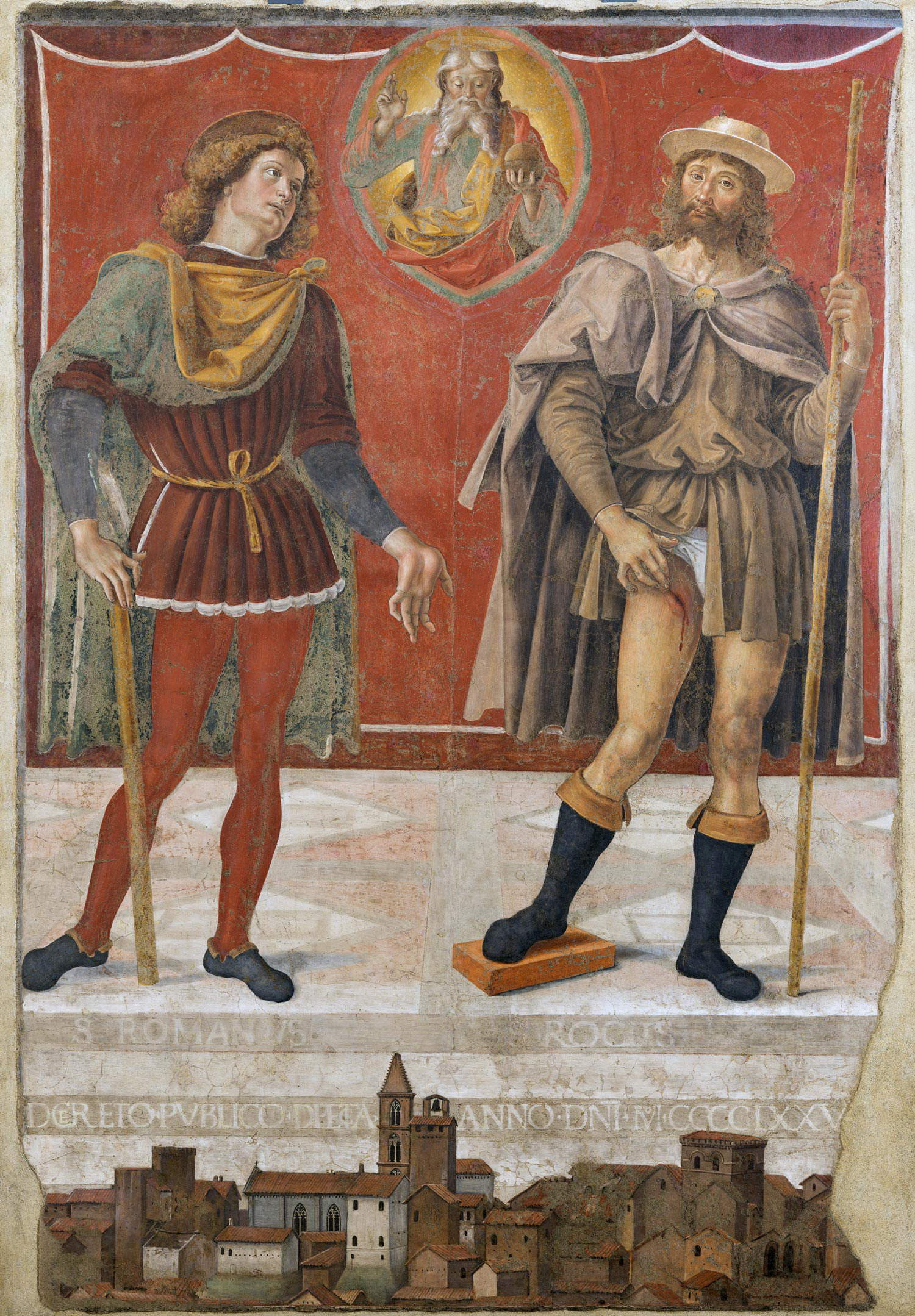
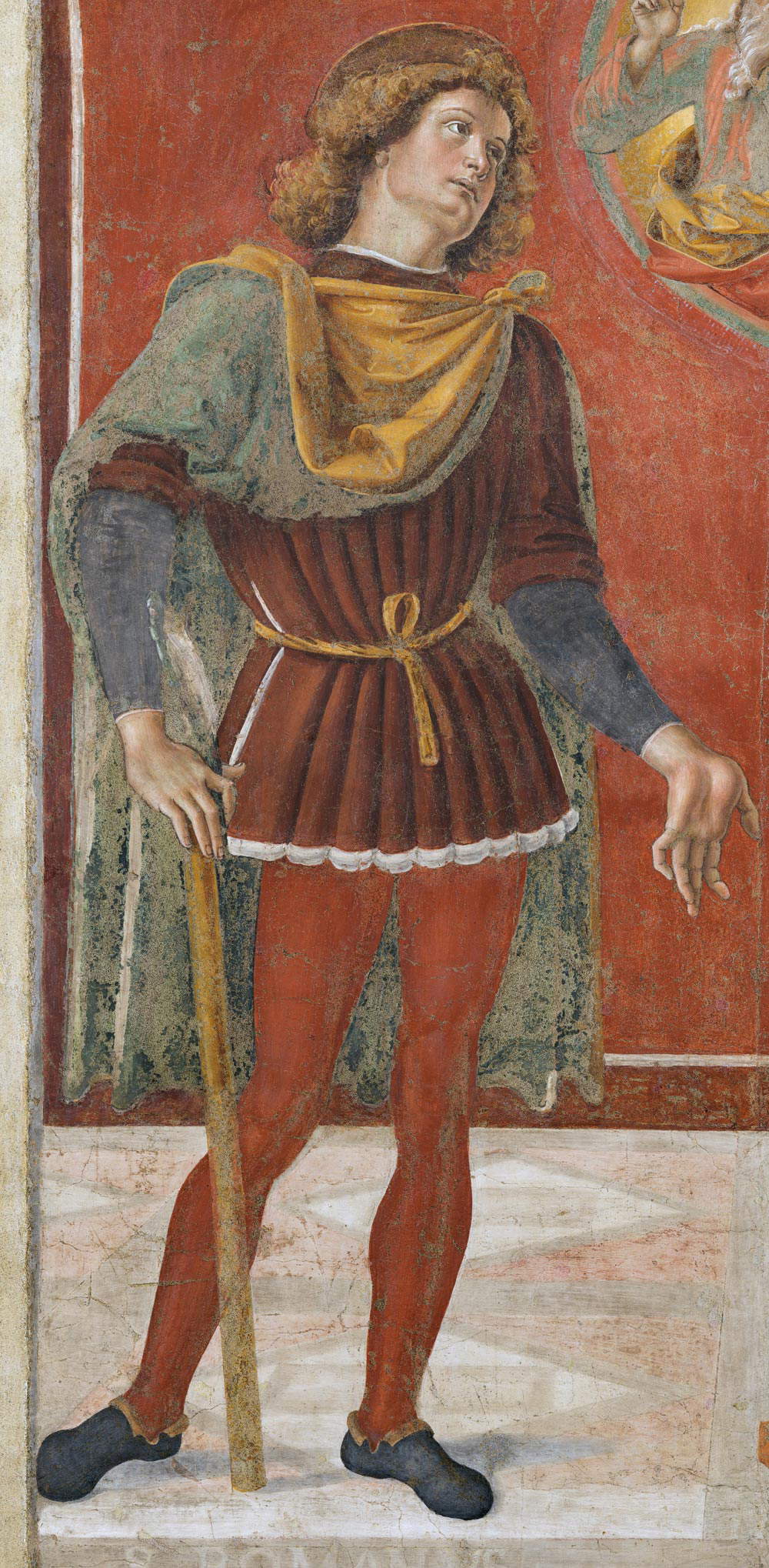
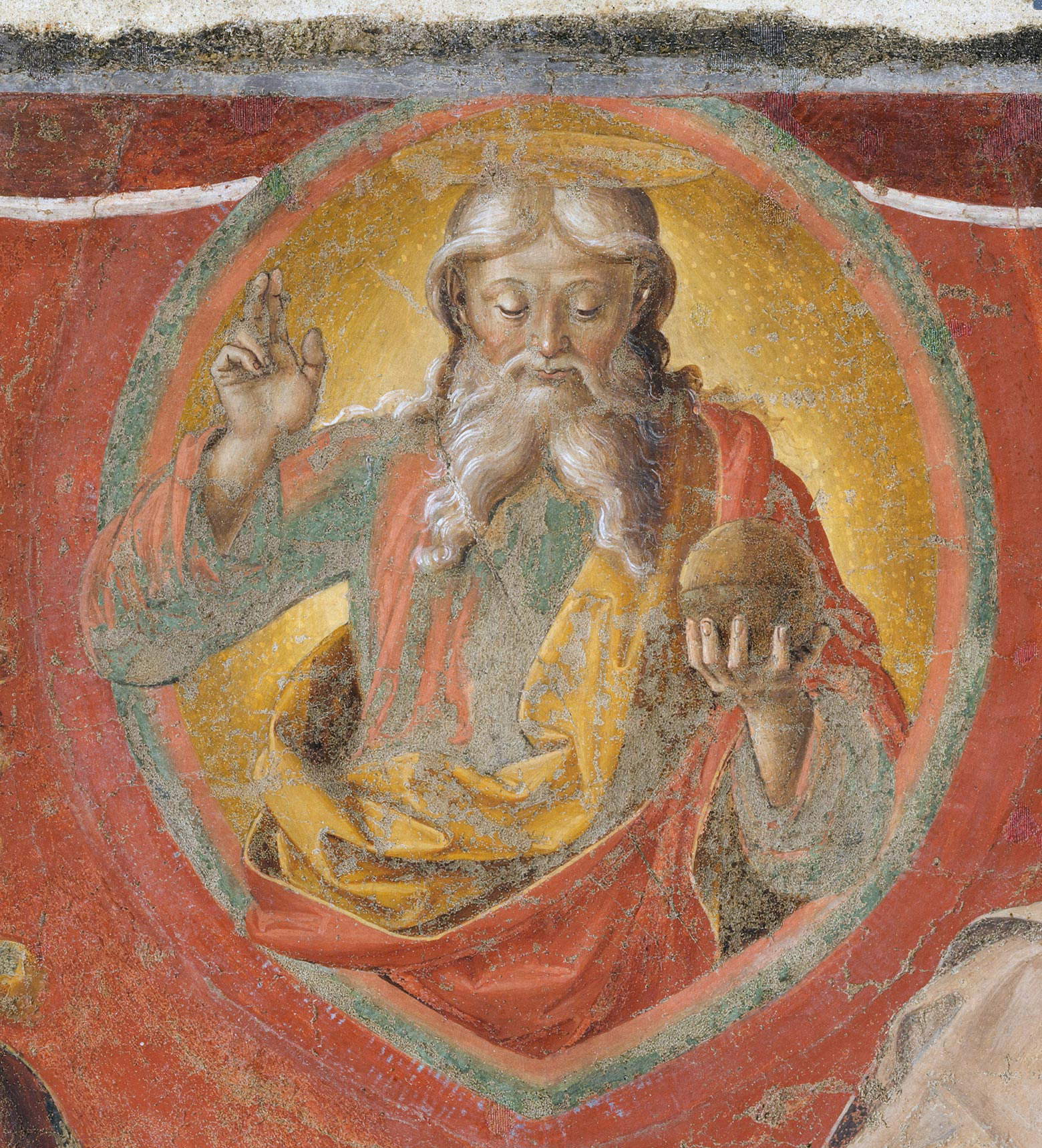
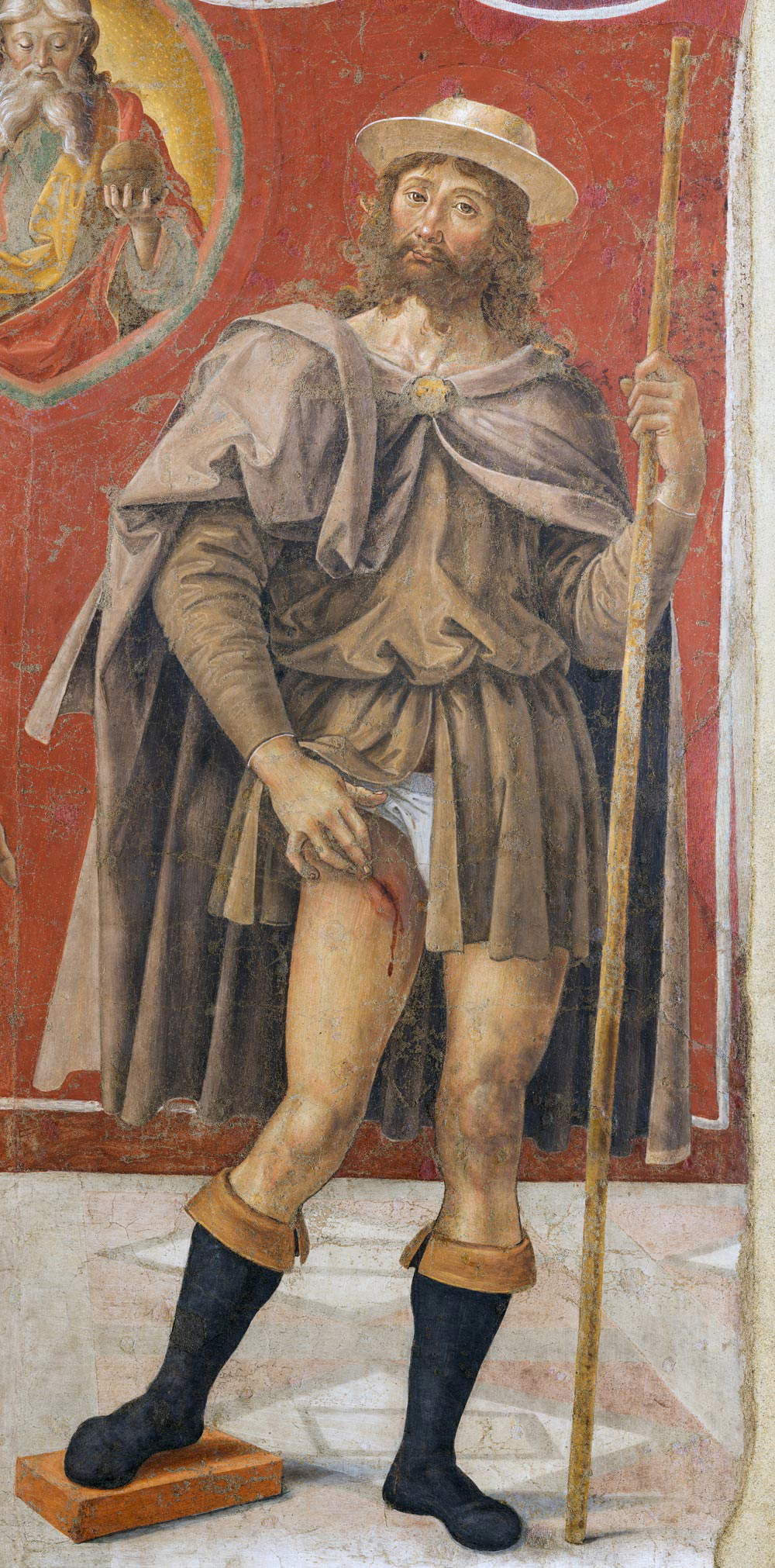


Born in Montpellier, France, it is said in fact that at a young age he lost both his parents and from that moment decided to sell all his possessions, join the Franciscan Third Order and go as a pilgrim to Rome to pray at the tombs of the apostles Peter and Paul. Upon arriving in Acquapendente, in the province of Viterbo, he served in the local hospital, ignoring the danger of the plague: invoking God and making the sign of the cross on the sick, he made miraculous healings and continued even afterwards to help the plague victims. It was in Rome, however, that his most famous miracle occurred: he healed a cardinal by tracing the sign of the cross on his forehead. When years later he discovered in Piacenza that he too had been infected by the plague, he went to take refuge in a hut in a forest near Sarmato near the Trebbia River: here a dog found him and saved him from death by bringing him a piece of bread every day. God did not allow the young pilgrim to die of the plague so that he could continue his work of caring for the sick. On his way home he was arrested as a suspicious person and taken to Voghera before the governor. He was imprisoned for five years: before dying in his cell, however, the saint obtained from God the gift of becoming the intercessor of all plague sufferers who invoked him. This is why Saint Roch became the protector of plague victims and of contagious diseases in general, and thus in perfect harmony with the reason for the creation of the Deruta work.
In the essay Forms and Colors of the Umbrian Landscape, written by scholars from the University of Perugia (Fabio Fatichenti, Laura Melelli, Mirko Santanicchia, Biancamaria Torquatie and Sonia Venanzi), it is also pointed out that Deruta’s “essence as a city of clay : see in this sense both the chromatic lighting of the brick buildings and the brick placed under the foot of Saint Roch, functional yes to make the posture of the saint credible, but according to a choice that in this context is anything but incidental and alludes to the ’productive’ soul of the city.”
The saints and the mandorla with the Eternal Father stand out on a kind of red drape, and the former rest their feet on a geometrically shaped floor with squares and lozenges.
Iconographically inspired by Umbrian “contra pestem” gonfalons, the Deruta fresco also takes elements from other works by Perugino made around the same time, such as the head of St. Rocco that looks very similar to that of Balthazar in theAdoration of the Magi in the National Gallery of Umbria, or the geometric floor in the Miracle of the Stillborn Child, a tablet from the series of the Miracles of St. Bernardino attributed to Perugino and workshop also housed in the Gallery.
In the Eternal Father between Saints Rocco and Romano , an influence of Piero della Francesca has also been seen, particularly in the view of the village of Deruta, which recalls those of Arezzo, and in the perfect circle of the brims of Saint Rocco’s hat, which recalls the painter’s mirror auras.
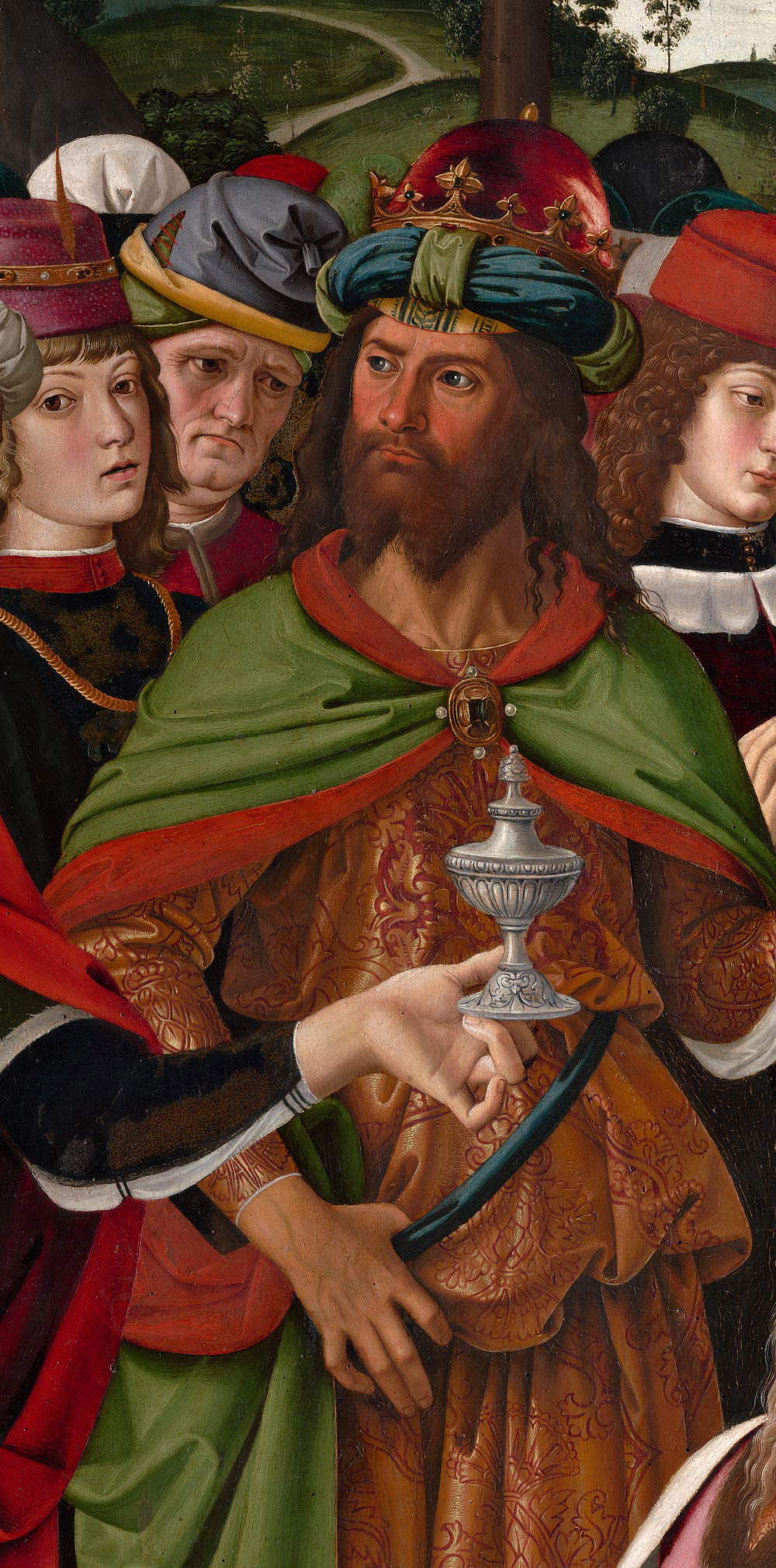

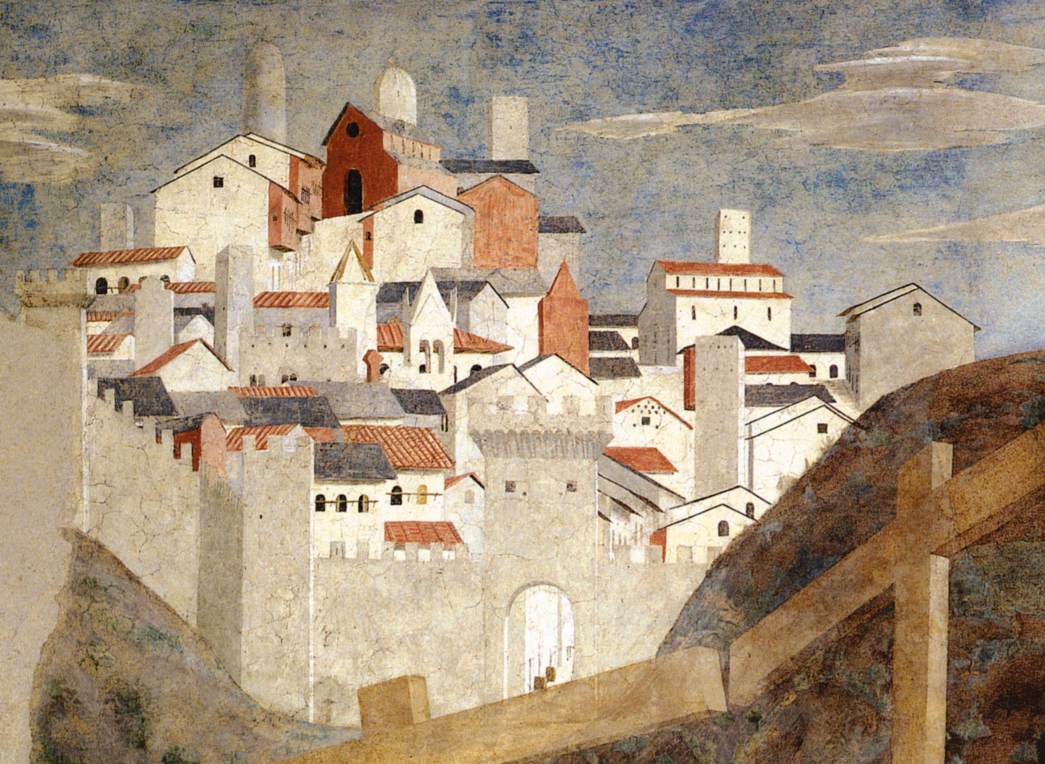
The work was discovered quite accidentally in 1846, when the canvas placed on the first altar on the left in the church of San Francesco was removed, and was immediately judged by scholars to be very interesting because of its high pictorial quality. In 1855 it was attributed by Luigi Carattoli to the Perugian artist Fiorenzo di Lorenzo. This attribution was largely accepted until in 1984 Pietro Scarpellini named it after Perugino following new studies on the painter’s early phase , and the attributional proposal was fully accepted by later critics. Wrote Scarpellini: “We are before the primary cell of the Perugino language that would later come to impose itself everywhere.” He continued: “The two young saints, with their way of moving on the plane at an almost dancing rhythm, allude to a very particular way of interpreting Pollaiolo and Verrocchio, which is precisely that of Pietro. Indeed, it is precisely here that the sprung movement, the internal rhythmic cadence of the bodies begins to become more precise, whereby the legs are arranged on the bottoms in a sort of elegant silhouette [...] a way of softening the jerky, shapely muscular inventions of the models in order to bend them to a rhythmic sense that also ends up becoming a sort of new compositional grammar.”
During the restoration work carried out in 1997 under the direction of Giovanni Manuali thanks to theArcheo Club of Perugia, during which the painting was transferred to a more suitable (a fiberglass panel with a layer of cork intervention), the removal of the previous pictorial additions and the watercolor retouching of the lacunose parts, it was discovered from the analysis of the pictorial surface that Perugino created the fresco in more than ten days: a rather extended time for the size of the work, but justifiable by the special care with which the work was accomplished. It took him no less than three days to realize the view of Deruta, of great technical finesse and topographical lucidity.
The fresco was restored for the first time since its discovery in 1908 following Carattoli’s denunciation of its poor state of preservation, who was already suggesting that it be detached in order to “remove it from the dampness in which it is at the present time.” But already three years later inspector Luigi Fiocca was still denouncing the poor state of preservation. The detachment had to wait many more years, as it was carried out in 1953 following a further report denouncing its deterioration. The detachment was carried out by Luigi Fumi and on this occasion gaps present on the pictorial surface were also reintegrated.
The work remained in the church of San Francesco until 1975, when in conjunction with the reopening of the Pinacoteca Comunale it was transferred to the Palazzo dei Consoli, where it still stands today, thus being able to admire in excellent condition Perugino’s masterpiece fresco.
The article is written as part of “Pills of Perugino,” a project that is part of the initiatives for the dissemination and diffusion of knowledge of the figure and work of Perugino selected by the Promoting Committee of the celebrations for the fifth centenary of the death of the painter Pietro Vannucci known as “il Perugino,” established in 2022 by the Ministry of Culture. The project, edited by the editorial staff of Finestre Sull’Arte, is co-financed with funds made available to the Committee by the Ministry.
Warning: the translation into English of the original Italian article was created using automatic tools. We undertake to review all articles, but we do not guarantee the total absence of inaccuracies in the translation due to the program. You can find the original by clicking on the ITA button. If you find any mistake,please contact us.





























